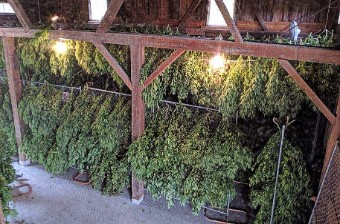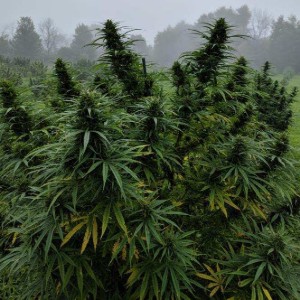Evaluating CBD Hemp Strains for Growing
Growing & Processing CBD Hemp Plants
CBD to THC Ratios
The question that needs to be answered about hemp strains & genetics is:”What percentage of CBD should be present when the THC percentage approaches the legal limit for this industrial hemp strain?” By testing for a strain’s CBD to THC ratio the answer to the question can be approximated with enough precision to confidently put a high CBD industrial hemp growing plan in place. It allows hemp seed selection with a good level of insight as to how it will perform.
Our research indicates that a cannabis strain’s CBD to THC ratio remains relatively stable throughout its growth cycle. Of course the same growing condition variables outlined on the home page can influence these ratio values too. Cannabis has proven to be an unbelievably vital species that is constantly adapting to its environment. When growing & processing feminized hemp, the quality and quantity of a grower’s harvest will depend on latitude, the nutrient program, weather conditions, soil composition and quality, attention and care during growth – plus any other considerations that could be called good growing techniques. After that, the timing of the harvest and the methods for processing, drying and storing or processing of the flower will determine the final quality and quantity of oil.
At this early stage in the industry, strains are not developed for different latitudes or weather conditions. Cheyenne Mountain Seed Company is a high CBD hemp seed supplier, and therefore our strains are hybrids of cannabis sativa and cannabis indica, like any other high CBD hemp strain. They will grow vigorously in Florida as well as Maine. For each latitude, the feminized hemp seeds would have to be germinated and vegetated at the proper time of year for a favorable amount of time to a determined stage of size and development, then planted in the field under favorable conditions. All of that is the grower’s responsibility.
Beyond that, as far as medical values go, a strain should be selected based on its full cannabinoid profile as well as its terpenoid profile.
The small table to the right illustrates the way a lab will typically report cannabinoid test results. This particular test from a nearly mature Mountain Mango plant showed a CBD to THC ratio of 34:1 (9.35/0.27). Results when growing and processing feminized hemp will vary based on growing conditions, including field irrigation. Growers report ratios of 27:1 to 35:1 in the field for our proprietary strain.

Mountain Mango Hanging In the Rafters
| Total Cannabinoids | |
|---|---|
| Analyte | Total* |
| THC | 0.27% |
| CBD | 9.35% |
| CBG | 0.23% |
| CBC | 0.92% |
| CBDV | 0.22% |
Knowing the CBD to THC ratio of the strains being planted and the consequent maximum CBD percentage yield possible under the law, rational business plans can be made. The amount of CBD produced can be calculated if the expected dried flower yield per plant is accurate. A simple formula: dried flower weight yield per plant X number of plants X tested CBD percentage = CBD yield. 100 plants with dry weight of 2 lbs. each testing at 7% CBD will yield 14 lbs of CBD in the extracted oil.
When growing and processing feminized hemp, the processing or extraction method that is used to process your crop will determine the actual product that will be sold. In our opinion, high quality crops should be extracted with a state of the art ethanol extraction system, this will yield the purest full-spectrum oil. It will be about 80-85% CBD, the other cannabinoids, terpenes and flavonoids make up the rest of the yield (assuming the extractor removed the unwanted waxes, lipids and chloryphyll). In the above example, the 100 plants would yield around 16.5 lbs of full-spectrum oil, about 7.5 kilos or 7.5 liters (kilos and liters are pretty much equal for oil).
Timing is Everything
The trick in growing & processing feminized hemp seed is knowing when to harvest each strain in the field. It’s the difference between success and a complete wipe out (regulator mandated crop destruction).
Whatever merits or pitfalls the current industrial hemp regulations possess, federal or state, as growers we are obliged to fully comply with them. Now, it’s all about the testing.
The only way to know when to harvest any strain in the field is to test, test, test. Simply put, when the THC level tests close to the legal limit, harvest the strain. All the nuances beyond that are up to the individual grower; how long to wait, how many tests to perform, how to gather your samples, how many days it will take to harvest the strain, etc.
Before getting started, we recommend you read our pre-flower cultivation information for optimal growing conditions.
Hemp Strains & Genetics: The CBD to THC Ratio Table
The table to the right shows the calculated CBD percentage of a hypothetical hemp test sample when the THC level reaches 0.3% for the following CBD to THC ratios.
As an example, for a strain to yield a 15% CBD percentage in the field at 0.3% THC, its CBD to THC ratio would have to test around 50:1, extremely high and rare!

Mountain Mango – Wisconsin October Morning
| Tested CBD:THC Ratio | Calculated CBD % at 0.3% THC |
|---|---|
| 10:1 | 3.00 |
| 20:1 | 6.00 |
| 25:1 | 7.50 |
| 30:1 | 9.00 |
| 35:1 | 10.50 |
| 40:1 | 12.00 |
| 50:1 | 15.00 |
| 60:1 | 18.00 |
| 70:1 | 21.00 |
| 80:1 | 24.00 |
| 90:1 | 27.00 |
| 100:1 | 30.00 |

